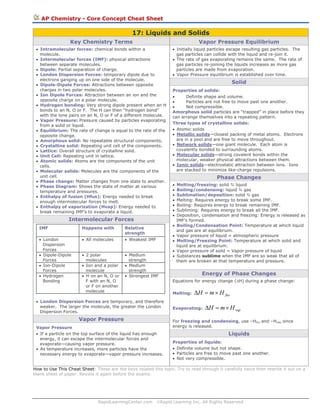Contenu connexe
Similaire à Liquids andsolids cheat sheet
Similaire à Liquids andsolids cheat sheet (20)
Plus de Timothy Welsh (20)
Liquids andsolids cheat sheet
- 1. AP Chemistry - Core Concept Cheat Sheet
17: Liquids and Solids
Key Chemistry Terms
Vapor Pressure Equilibrium
• Intramolecular forces: chemical bonds within a
molecule.
• Intermolecular forces (IMF): physical attractions
between separate molecules.
• Dipole: Partial separation of charge.
• London Dispersion Forces: temporary dipole due to
electrons ganging up on one side of the molecule.
• Dipole-Dipole Forces: Attractions between opposite
charges in two polar molecules.
• Ion Dipole Forces: Attraction between an ion and the
opposite charge on a polar molecule.
• Hydrogen bonding: Very strong dipole present when an H
bonds to an N, O or F. The H can then “hydrogen bond”
with the lone pairs on an N, O or F of a different molecule.
• Vapor Pressure: Pressure caused by particles evaporating
from a solid or liquid.
• Equilibrium: The rate of change is equal to the rate of the
opposite change.
• Amorphous solid: No repeatable structural components.
• Crystalline solid: Repeating unit cell of the components.
• Lattice: Overall structure of crystalline solid.
• Unit Cell: Repeating unit in lattice.
• Atomic solids: Atoms are the components of the unit
cells.
• Molecular solids: Molecules are the components of the
unit cell.
• Phase change: Matter changes from one state to another.
• Phase Diagram: Shows the state of matter at various
temperature and pressures.
• Enthalpy of fusion (Hfus): Energy needed to break
enough intermolecular forces to melt.
• Enthalpy of vaporization (Hvap): Energy needed to
break remaining IMF’s to evaporate a liquid.
Intermolecular Forces
• Initially liquid particles escape resulting gas particles. The
gas particles can collide with the liquid and re-join it.
• The rate of gas evaporating remains the same. The rate of
gas particles re-joining the liquids increases as more gas
particles are made from evaporation.
• Vapor Pressure equilibrium is established over time.
Solid
Properties of solids:
•
Definite shape and volume.
•
Particles are not free to move past one another.
•
Not compressible.
Amorphous solid particles are “trapped” in place before they
can arrange themselves into a repeating pattern.
Three types of crystalline solids:
• Atomic solids
• Metallic solids—closest packing of metal atoms. Electrons
are in a pool and are free to move throughout.
• Network solids—one giant molecule. Each atom is
covalently bonded to surrounding atoms.
• Molecular solids—strong covalent bonds within the
molecular, weaker physical attractions between them.
• Ionic solids—electrostatic attraction between ions. Ions
are stacked to minimize like-charge repulsions.
Phase Changes
•
•
•
•
•
•
•
•
IMF
Happens with
Relative
strength
• London
Dispersion
Forces
• Dipole-Dipole
Forces
• Ion-Dipole
Forces
• Hydrogen
Bonding
• All molecules
• Weakest IMF
• 2 polar
molecules
• Ion and a polar
molecule
• H on an N, O or
F with an N, O
or F on another
molecule
• Medium
strength
• Medium
strength
• Strongest IMF
•
•
•
•
Melting/freezing: solid
liquid
Boiling/condensing: liquid
gas
Sublimation/deposition: solid
gas
Melting: Requires energy to break some IMF.
Boiling: Requires energy to break remaining IMF.
Subliming: Requires energy to break all the IMF.
Deposition, condensation and freezing: Energy is released as
IMF’s formed.
Boiling/Condensation Point: Temperature at which liquid
and gas are at equilibrium.
Vapor pressure of liquid = atmospheric pressure
Melting/Freezing Point: Temperature at which solid and
liquid are at equilibrium.
Vapor pressure of solid = Vapor pressure of liquid
Substances sublime when the IMF are so weak that all of
them are broken at that temperature and pressure.
Energy of Phase Changes
Equations for energy change (ΔH) during a phase change:
Melting:
• London Dispersion Forces are temporary, and therefore
weaker. The larger the molecule, the greater the London
Dispersion Forces.
Vapor Pressure
Vapor Pressure
• If a particle on the top surface of the liquid has enough
energy, it can escape the intermolecular forces and
evaporate—causing vapor pressure.
• As temperature increases, more particles have the
necessary energy to evaporate—vapor pressure increases.
ΔH = m × H fus
Evaporating:
ΔH = m × H vap
For freezing and condensing, use –Hfus and –Hvap since
energy is released.
Liquids
Properties of liquids:
• Definite volume but not shape.
• Particles are free to move past one another.
• Not very compressible.
How to Use This Cheat Sheet: These are the keys related this topic. Try to read through it carefully twice then rewrite it out on a
blank sheet of paper. Review it again before the exams.
RapidLearningCenter.com
©Rapid Learning Inc. All Rights Reserved

